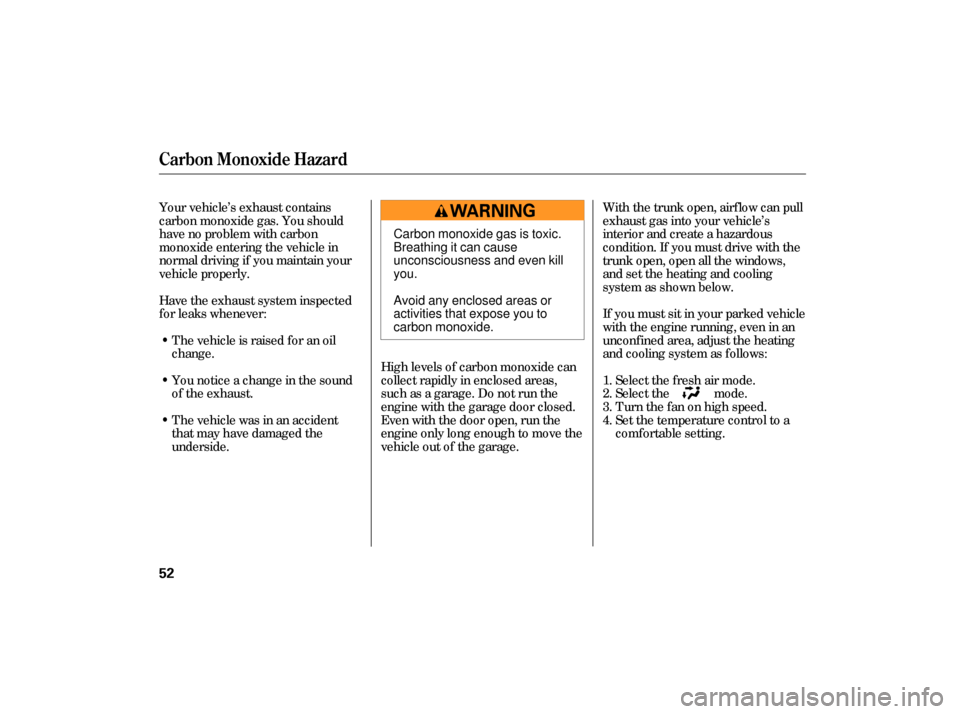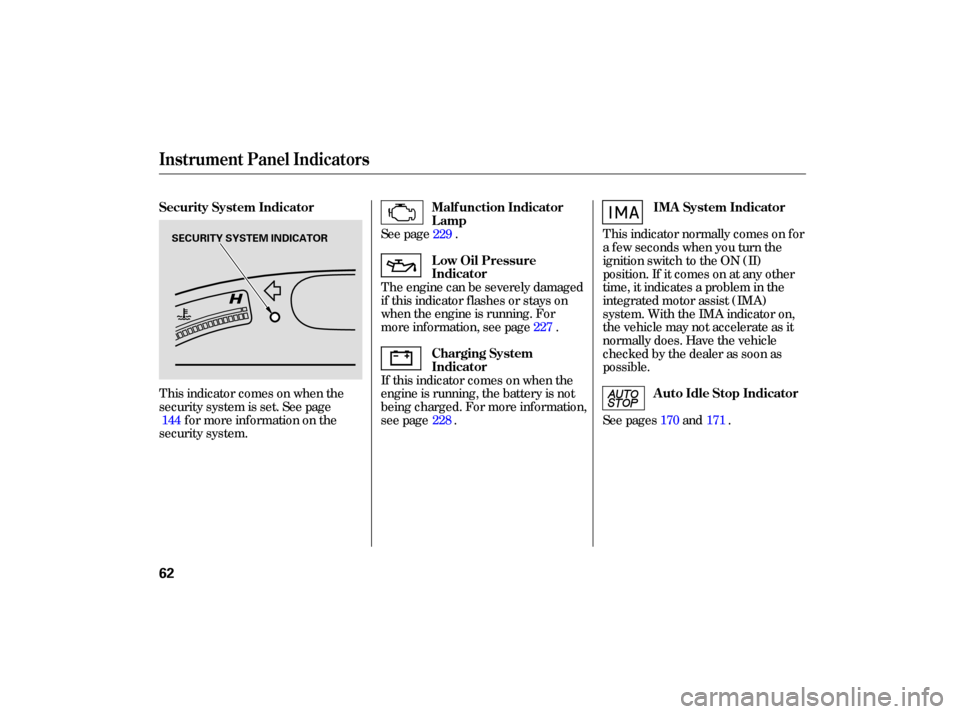Page 54 of 267

Your vehicle’s exhaust contains
carbon monoxide gas. You should
have no problem with carbon
monoxide entering the vehicle in
normal driving if you maintain your
vehicle properly.High levels of carbon monoxide can
collect rapidly in enclosed areas,
such as a garage. Do not run the
engine with the garage door closed.
Even with the door open, run the
engine only long enough to move the
vehicle out of the garage.If you must sit in your parked vehicle
with the engine running, even in an
unconf ined area, adjust the heating
and cooling system as f ollows:
Select the f resh air mode.
Select the mode.
Turn the f an on high speed.
Set the temperature control to a
comfortable setting.
The vehicle is raised f or an oil
change.
Have the exhaust system inspected
f or leaks whenever:
You notice a change in the sound
of the exhaust.
The vehicle was in an accident
that may have damaged the
underside. With the trunk open, airf low can pull
exhaust gas into your vehicle’s
interior and create a hazardous
condition. If you must drive with the
trunk open, open all the windows,
and set the heating and cooling
system as shown below.
1.
2.
3.
4.
Carbon Monoxide Hazard
52
Carbon monoxide gas is toxic.
Breathing it can cause
unconsciousness and even kill
you.
Avoid any enclosed areas or
activities that expose you to
carbon monoxide.
�����—�����—�����y�
���������
���y���
�(�#���������y���������y
Page 64 of 267

The engine can be severely damaged
if this indicator flashes or stays on
when the engine is running. For
more information, see page .
If this indicator comes on when the
engine is running, the battery is not
being charged. For more information,
see page .
See
page .
This indicator comes on when the
security system is set. See page
for more information on the
security system. This
indicator normally comes on for
a few seconds when you turn the
ignition switch to the ON (II)
position. If it comes on at any other
time, it indicates a problem in the
integrated motor assist (IMA)
system. With the IMA indicator on,
the vehicle may not accelerate as it
normally does. Have the vehicle
checked by the dealer as soon as
possible.
See pages and .
144 229
227
228 170 171
Instrument Panel Indicators
Security System Indicator Malf unction Indicator
Lamp
L ow Oil Pressure
Indicator
Charging System
Indicator IMA System Indicator
A uto Idle Stop Indicator
62
SECURITY SYSTEM INDICATOR
�����—�����—�����y�
�������������y���
�(�#���������y���������y
Page 66 of 267
To switch the information display
between the odometer, trip meter,
outside temperature, and engine oil
lif e and maintenance item code(s),
press the SEL/RESET button
repeatedly.
The odometer shows the total
distance your vehicle has been
driven. It measures in miles or
kilometers. It is illegal under U.S.
federal law and Canadian provincial
regulations to disconnect, reset, or
alter the odometer with the intent to
change the number of miles or
kilometers indicated.
Gauges
Odometer
64
TRIP METER
SPEEDOMETER
FUEL
GAUGE
SEL/RESET BUTTON DISPLAY CHANGE BUTTON INFORMATION
DISPLAY
TACHOMETER
ODOMETER/OUTSIDE
TEMPERATURE INDICATOR INSTRUMENT PANEL BRIGHTNESS CONTROL BUTTONS
CURRENT FUEL MILEAGE/
TEMPERATURE GAUGE
�����—�����—�����y�
���������
���y���
�(�#���������y���������y
Page 70 of 267

If your fuel cap is loose or missing, a
‘‘CHECK FUEL CAP’’ message
appears in the information display
after you start the engine. Turn the
engine off and confirm the fuel cap is
installed. If it is, loosen the cap, then
retighten it until it clicks at least
once. When you restart the engine,
the message appears again. To clear
the message, press and hold the
SEL/RESET button until it goes
away. If
the system still detects a loose or
missing fuel fill cap, the malfunction
indicator lamp (MIL) comes on.
Turn the engine off, and check or
retighten the fuel fill cap until it
clicks at least once. The MIL goes
out after several days of normal
driving once the cap is tightened or
replaced. If it does not go out, have
your dealer inspect the vehicle. For
more information, see page .The
information display in the
instrument panel shows you the
engine oil life and maintenance
service items when the ignition
switch is in the ON (II) position. This
information helps to keep you aware
of the periodic maintenance your
vehicle needs for continued trouble-
free driving. Refer to page for
more inf ormation.
229 179
Gauges
Check Fuel Cap Indicator
Maintenance Minder
68
�����—�����—�����y�
�������������y���
�(�#���������y�������
�y
Page 151 of 267
Bef ore you begin driving your
vehicle, you should know what
gasoline to use and how to check the
levels of important f luids. You also
need to know how to properly store
luggage or packages. The
inf ormation in this section will help
you. If you plan to add any
accessories to your vehicle, please
read the information in this section
first..............................
Break-in Period .150
.................
Fuel Recommendation .150
.........
Service Station Procedures .151
....................................
Ref ueling .151
OpeningandClosingthe
.......................................
Hood .152
...................................
Oil Check .153
.............
Engine Coolant Check .154
...............................
Fuel Economy .154
...
Accessories and Modif ications .156
.............................
Carrying Cargo .158
Bef ore Driving
Bef ore Driving
149
�����—�����—�����y�
����
��������y���
�(�#���������y���
�����y
Page 152 of 267

Help assure your vehicle’s f uture
reliability and perf ormance by paying
extra attention to how you drive
during the f irst 600 miles (1,000 km).
During this period:Avoid full-throttle starts and rapid
acceleration.
You should also f ollow these
recommendations with an
overhauled or exchanged engine, or
when the brakes are replaced. Your vehicle is designed to operate
on unleaded gasoline with a pump
octane number of 87 or higher. Use
of a lower octane gasoline can cause
a persistent, heavy metallic rapping
noise that can lead to engine damage.
Do not change the oil until the
scheduled maintenance time.
Avoidhardbrakingforthefirst
200 miles (300 km). Using gasoline containing lead will
damage your vehicle’s emissions
controls. This contributes to air
pollution.
In addition, in order to maintain good
perf ormance, f uel economy, and
emissions control, we strongly
recommend, in areas where it is
available, the use of gasoline that
does NOT contain manganese-based
f uel additives such as MMT. We recommended using a quality
gasoline containing detergent
additives that help prevent fuel
system and engine deposits. Use of gasoline with these additives
may adversely af f ect perf ormance,
and cause the malfunction indicator
lamp on your instrument panel to
come on. If this happens, contact
your authorized dealer f or service.
Some gasoline today is blended with
oxygenates such as ethanol or
MTBE. Your vehicle is designed to
operate on oxygenated gasoline
containing up to 10 % ethanol by
volume and up to 15 % MTBE by
volume. Do not use gasoline
containing methanol.
If you notice any undesirable
operating symptoms, try another
service station or switch to another
brand of gasoline.
For f urther important f uel-related
inf ormation, please ref er to your
.
Break-in Period Fuel Recommendation
Quick Start Guide
Break-in Period, Fuel Recommendation
150
�����—�����—�����y�
����
��������y���
�(�#���������y���
�����y
Page 155 of 267
Remove the dipstick again, and
check the level. It should be
between the upper and lower
marks.
Wait
a few minutes after turning the
engine off before you check the oil.
Remove the dipstick (orange loop).
Wipe the dipstick with a clean
cloth or paper towel.
Insert it all the way back in its tube.
To
close the hood, lift it up slightly to
remove the support rod from the
hole. Put the support rod back into
its holding clip. Lower the hood to
about a foot (30 cm) above the
fender, then let it drop. Make sure it
is securely latched. If it is near or below the lower mark,
see
on page .
2.
3. 1. 4.
192
Service Station Procedures
Oil Check
A dding Engine Oil
Bef ore Driving
153
DIPSTICK UPPER MARK
LOWER MARK
SUPPORT ROD
CLIP
GRIP
�����—�����—�����y�
����
��������y���
�(�#���������y���
�����y
Page 156 of 267

Drive moderately. Rapid
acceleration, abrupt cornering,
and hard braking use more fuel.
Always drive in the highest gear
possible.
Always maintain your vehicle
according to the maintenance
schedule. See
(see page
).
an underinflated tire
causes more ‘‘rolling resistance,’’
which u ses more fuel.
Engine oil also affects fuel
economy. The fuel efficient, low-
vi scosity 0W-20 oil recommended
for your Civic Hybrid is
formulated to help the engine use
less fu el. This oil is available at
your dealer.
The build-up of snow or mud on
your vehicl e’s underside adds
weight and rolling resistance.
Frequent cl eaning helps your fuel
mileage and reduces the chance of
corrosion.
Look at the coolant level in the
radiator reserve tank. Make sure it is
between
the MAX and MIN lines. If
it is below the MIN line, see
on page .
Refer to
on page for information
about checking other items on your
vehicle. You may find that your Civic Hybrid’s
unique combination of an engine and
an electric motor has driving
characteristics that are somewhat
dif f erent f rom what you are used to.
192
184 184
For example,
Service Station Procedures, Fuel Economy
Improving Fuel Economy
Owner’s
Maintenance Checks
Engine Coolant Check
A dding
Engine Coolant
Owner’s Maintenance
Checks
154
MAX
MIN RESERVE TANK
�����—�����—�����y�
����
��������y���
�(�#���������y���
�����y